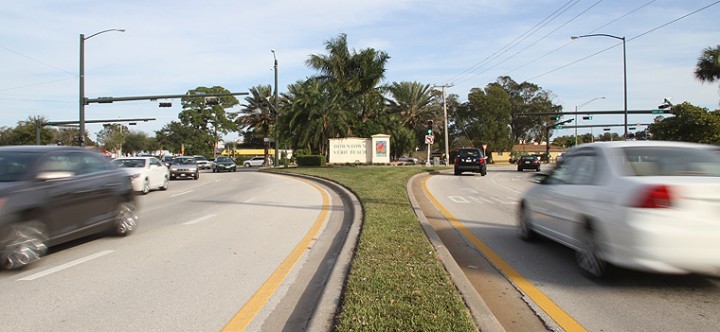
VERO BEACH — Terry Torres has his job cut out for him. The president of the local Main Street program – which like similar state and national programs promotes the idea of bringing people back to downtowns that became ghost towns – said education is key to getting people to buy into the idea that altering the so-called Twin Pairs will spur business and improve pedestrian safety while increasing driving time by only about 30 seconds.
A vibrant downtown, says Torres, a barrier island resident, will benefit the community and not just during the monthly art walks and Downtown Friday events.
“It won’t happen overnight, but it will be a public-private enterprise,” said Torres. “There must be a marriage between the public and private sector.”
A recent study by the Vero consulting group, Kimley-Horn and Associates, said reducing the number of lanes in the westbound segment of the Twin Pairs from four lanes to two and reducing eastbound 21st Street from three lanes to two from 20th Avenue to the railroad tracks would not have an adverse impact on traffic along the pairs or other area streets.
Only 21st Street is expected to see an increase in traffic. The Vero Beach City Council is expected to review the Kimley-Horn plan next month and discuss three proposals for the downtown.
The report comes seven years after the city’s own study in 2006 determined that changing the traffic flow of State Road 60 into reduced lanes with two-way traffic flows couldn’t be justified because of the negative impact on neighboring residential streets.
The new study says otherwise. Under the current configuration, the Twin Pairs essentially serve to move traffic through downtown rather than promote the downtown as a destination, the study says.
The idea is to turn some current travel lanes into about 80 parking spots.
The parking spots – which would be 11.5 feet wide – would be much wider and longer than typical eight-foot wide parallel parking spots, making it easier for parking motorists to avoid running into anyone in the bike lane.
Expanded parking spots will also make it easier for motorists to get in and out without tying up traffic, according to the plan.
Under the plan, the bicycle lanes would be widened from the current four feet to five feet and the travel lanes would also be widened. The idea is to try and get the state to sign off on a plan that would reduce the speed limit in that area from 40 to 35 mph.
“Try and cross those lanes right now and see what it is like,” said Torres, who is also the owner of SLC Commercial Bird Realty in downtown. “God forbid if you try and cross where there is not a light.”
Critics of the plan are expected to be vocal as matters moves forward.
For starters, the plan will cost at least $680,000 if the city only restripes the lanes’ parking spots and could run $1.9 million if the ultimate plan involved bumped-out curbs and landscaping.
“I’m against two lanes,” said Mark Mucher, a member of the Vero Beach Planning and Zoning Commission which in December reviewed a draft of the proposal.
But Barbara Hoffman, the chairwoman of the board of Cultural Council of Indian River County, has a different view.
“The issue today is not about asphalt, but about making the art district an exciting, viable place for businesses to grow and prosper, for residents and visitors to shop, eat and play and to provide a beautiful and safe place we can all feel proud to say is our downtown.”



